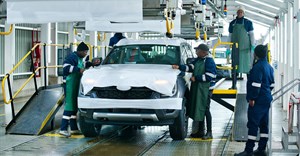Trending

 East Africa internet disrupted by another major undersea cable cutLindsey Schutters
East Africa internet disrupted by another major undersea cable cutLindsey Schutters
 George building collapse: 44 remain missingKatja Hamilton
George building collapse: 44 remain missingKatja Hamilton First of its kind MACC Fund to raise R10.2bn to transform creative industryDanette Breitenbach
First of its kind MACC Fund to raise R10.2bn to transform creative industryDanette Breitenbach
Elections 2024
5 safety tips for female drivers

From reckless driving to potholes and wild animals, safety is a cause for concern on South African roads. And whilst car safety features continue to improve exponentially with advancements in reinforced chassis, computerised warning systems, and side-impact beams, the position the driver takes inside the cabin is still of utmost importance, especially for women.
The first female crash test dummy was developed in 2012 by Swedish university, Chalmers University of Technology. Lead researcher, Anna Carlsson, who produced the first prototype, was motivated to design EvaRID due to the high instances of whiplash recorded in female crash victims.
“Today, modern cars detect the driver’s height and weight, and position the protection system to suit these individual dimensions,” says AutoTrader’s CEO, George Mienie.
“So it's no longer a case of male or female, but rather how heavy or how tall you are” he comments.
However, the South African auto market mostly consists of second-hand vehicles, what the industry terms ‘an ageing car park’, meaning many cars on our roads today pre-date 2012 and don’t use the latest technology found in modern cars.
“This makes it important for women to adjust their driving position, to make sure they drive positioned in the safest part of the cabin” comments Mienie.
According to Devon Scott, Jaguar Land Rover’s lead instructor, women often sit too close to the steering wheel, whereas men tend to sit too low. This is usually because women are on average shorter than men.
In light of Women’s Month, Scott gives some advice and precautions to make sure female drivers are positioned correctly in their cockpits and, are, therefore, safer:
- When sitting upright in the driver seat, make sure there is at least one hand length of space between your head and the top of the roof. Use your seat adjuster to correct the height of your chair.
- When sitting behind the steering wheel, your legs mustn’t be fully extended. Move your seat forward or backwards with the seat adjuster until your legs are slightly bent.
- Steering wheels are (mostly) adjustable for reach. When sitting upright, extend one arm forward and adjust the steering wheel until your wrist is touching. You should not be closer than 27cm to an airbag.
- The seat headrest is not designed to rest your head on, but to help with whiplash when involved in an accident. Therefore, always make sure the top of the headrest is above your ears.
- Seatbelts are adjustable. It should never be across your neck, only ever across your chest.
“It might take some time getting used to a new seating position, but remember that your car is not your couch” comments Mienie.
“In order for the intelligently designed safety features to work effectively, women are advised to adjust their settings using these basic tips” he concludes.











